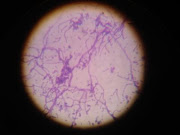doi:10.4269/ajtmh.21-0691
Copyright © 2021 by The American Society of Tropical
Medicine and Hygiene
Higher Prevalence of Extended Spectrum b-Lactamase
Producing Uropathogenic Escherichia coli Among Patients with Diabetes from a Tertiary Care
Hospital of Kathmandu, Nepal
Tulsi Nayaju1†, Milan Kumar Upreti1†, Alina Ghimire1, Basudha Shrestha2,
Basanta Maharjan2, Rajesh Dhoj Joshi2, Binod Lekhak3,
and Upendra Thapa Shrestha3*
1Department of Microbiology, GoldenGate International College, Kathmandu, Nepal;
2Kathmandu Model Hospital, Kathmandu, Nepal;
3Central Department of Microbiology, Tribhuvan University,
Kirtipur, Kathmandu, Nepal
*Address correspondence to Upendra Thapa Shrestha, Central
Department of Microbiology, Tribhuvan University, Kirtipur, Kathmandu, Bagmati
44600, Nepal. E-mail: upendra.thapashrestha@cdmi.tu.edu.np
†These authors contributed equally to this work.
ABSTRACT
This study aimed to determine the occurrence of antibiotic resistance genes
for b-lactamases; blaTEM and blaCTX-M in uropathogenic Escherichia coli isolate from urinary
tract infection (UTI) suspected diabetic and nondiabetic patients. A
hospital-based cross-sectional study was conducted in Kathmandu Model Hospital,
Kathmandu, in association with the Department of Microbiology, GoldenGate
International College, Kathmandu, Nepal, from June to December 2018. A total of
1,267 nonduplicate midstream urine specimens were obtained and processed
immediately for isolation of uropathogens. The isolates were subjected to
antibiotic susceptibility testing and extended-spectrum b-lactamase (ESBL) confirmation. In addition, blaTEM and blaCTX-M genes were detected using specific primers. The overall prevalence of UTI was 17.2%
(218/1,267), of which patients with diabetes were significantly more infected; 32.3% (31/96) as compared with
nonpatients with diabetes, 15.9% (187/1,171). A total of 221 bacterial isolates
were obtained from 218 culture-positive specimens in which E. coli was the most predominant; 67.9% (150/221). Forty-four percent (66/150) of the
total E. coli was multidrug-resistant and 37.3% (56/150) were ESBL producers. Among 56
isolates, 92.3% (12/13) were from patients with diabetes, and 83.0% (44/53)
were from nondiabetics. Furthermore, 84.9% of the screened ESBL producers were
confirmed to possess either single or both of blaTEM and blaCTX-M genes. The blaTEM and blaCTX-M genes were detected in 53.6% and 87.5% of
the phenotypically ESBL confirmed E. coli, respectively. Higher rates of ESBL
producing uropathogenic E. coli are associated among patients with diabetes causing an
alarming situation for disease management. However, second-line drugs with
broad antimicrobial properties are still found to be effective drugs for
multidrug-resistant strains.
Fulltext: Download






















